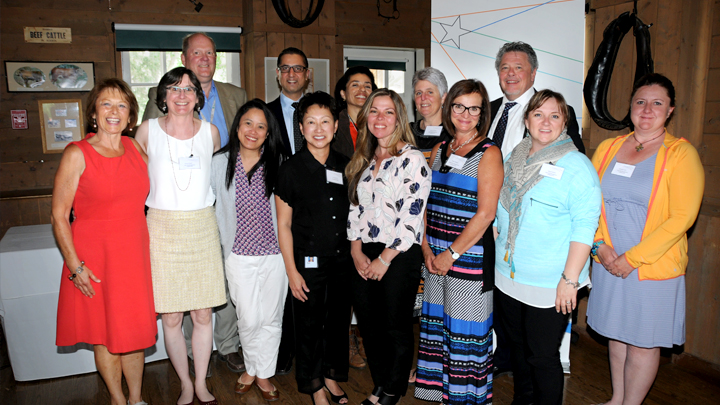
June 20, 2017

The Falls Risk Management Collaborative is a co-recipient of this year’s President’s Excellence Award in Quality Improvement.
Story by Sean Woods | Photo by Paul Rotzinger
Falls pose one of the greatest risks of injury to our patients.
When a patient falls, there’s an increased chance they will fall again in the future. And, when a fall results in injury, it not only reduces the patient’s quality of life, but also increases their length of hospital stay — costing the health system roughly $20,500 per fall.
“Something needed to be done,” says Anurag Pandey, executive director, process improvement. “Our leaders asked us to work with teams across the province to help reduce and prevent falls, which led us to starting the Falls Risk Management Collaborative in 2014.”
This learning collaborative developed processes and intervention practices to reduce falls. It brought teams together to focus on this common problem to learn from evidence-based best practice, from each other’s shared experiences and from improvement advisors who shared their quality-improvement methods.
They devised strategies to partner with patients and families to build risk awareness, implemented a falls-risk assessment on patient admission and developed care plans with patients and families to create new ways of reducing the risk of falls.
This work has helped to reduce the number of falls at participating sites, and earned the collaborative the 2016 President’s Excellence Award in Quality Improvement.
“We had 72 people involved across 11 teams,” says Ximena Mendoza, senior process improvement consultant. “We worked with them to develop a standard process to manage the risk of falls, and then each team could adapt it to their local needs.”
While reducing falls might seem like an easy thing do to, Pandey, the improvement lead for the collaborative, suggests otherwise.
“Picture this. I’m a 65-year-old person. I’m on medications that affect my balance, which already isn’t great to begin with. I suddenly get up to go the washroom — and I lose my balance and fall.”
“To prevent that, so many things have to go right.”
Teams employed many different techniques to reduce falls. For example, some lowered the height of beds so patients weren’t getting up from such a high point. Others gave patients non-slip socks to wear during their hospital stay.
“When we work on projects, we want to develop standard processes that are sustainable” says Mendoza,
“The tools we helped develop for the collaborative participant teams can currently be implemented and/or used by any team, and in any setting (including acute care, long-term care, home care) to help manage the risk of falls and ultimately reduce falls.”
According to Pandey, the best way to prevent falls is to do a thorough screening of patients when they first arrive on the unit, to determine their falls risk.
“We screen for things like ‘is the patient on medication that affects their balance’, examine the patient’s clinical history, and also their age,” says Pandey. “Once you have this information, you pay more attention to those at a higher risk and help reduce falls. These little things make a huge difference.”
That difference is already being seen in patient areas like Unit 58 at South Health Campus — a part of the collaborative — and a fellow recipient of the President’s Excellence Award in Quality Improvement.
Prior to putting their falls strategy in place, the unit was seeing around 20 falls per month, with only 60 per cent of falls reported in AHS’ Reporting and Learning System (RLS) for patient safety. (RLS is an online system for reporting patient safety incidents with the goal of sharing, learning and improving.).
Today, that number has been reduced to six falls, with 100 per cent of incidents now reported in RLS.
“Encouraging teams to record falls was a big goal of the collaborative,” says Mendoza. “That ensures we have accurate, quality data that teams can use to track their progress in reducing falls.”
Various teams who took part in the collaborative provided feedback on their progress, including the team at Beaverlodge Home Care.
“We improved communication among staff by implementing a process that needed to be followed on paper regularly,” they reported. “It brought forward areas of concern. Tracking (of falls) increased during the collaborative, which increased the safety of our clients. Staff feel more empowered to advocate for their clients’ needs.”
Pandey hopes the work will expand beyond the initial collaborative.
“It was an experiment,” he says. “One way we can really make a system-wide change in Alberta is to use the 11 teams of the collaborative as nuclei for 50 teams — (to) spread the learning. I’m trying to get each team to recruit five more in the second round of the collaborative. So we’ll get to 50, then 200, and so on. That’s how we will sustain these gains.”
The President’s Excellence Awards recognize and celebrate the dedication and accomplishments of AHS staff, physicians and teams. Award recipients demonstrate exceptional collaboration, innovation and a commitment to quality improvement and patient care.